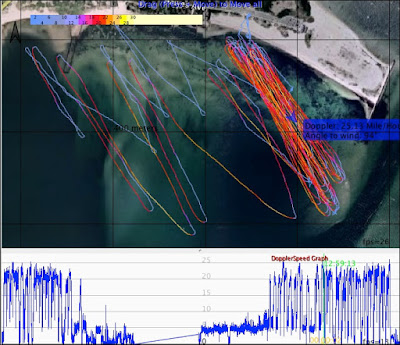Maybe I need to flap harder? Or maybe I need to grow a pair .. of wings, that is. Probably won't happen.
The picture is from a session two days ago at Kalmus. After sailing back and forth for 9 hours the day before (I call that "distance sailing"), it was time to do something different - a bit of old school freestyle. I'll refrain from doing any freestyle as long as I have any excuse - "the water is cold" or "I did not sail much recently" being two of my favorites. So I still count the Duck Jibe as a freestyle trick. It's tricky to catch the sail after throwing it! Works better than trying to fly, though.
The crash in the picture above was harmless - perhaps all that flapping helped, after all. A little while later (and a little more tired), I had a better crash. If you've learned the Duck Jibe, maybe you remember the "Plank Walk": when your mast hits the water, and your gear suddenly stops, but you keep going ... straight off the nose of your board. That's pretty much what I did. Here's the GoPro footage:
That was fun! As a little bonus, I set my top speed of the day during my brief flight, according to my GPS:
I was three knots faster than in my second-fastest run! If you believe the GPS, that is. I really don't think that I was airborne for longer than 2 seconds - I would have flown about a 100 feet in that time! So let's look at the data more closely:
Here is the narrative to what happened:
- I slowed down a bit during the sail duck, from 22 knots to 18.5 knots
- When the mast hit the water, the board came to a sudden stop. Not so my body! Since my foot was still in the strap, the upper body did not just keep the speed, but actually accelerated from 18.5 to 26 knots within 0.4 seconds
- I hit the water shortly thereafter. As soon as my hand was deeper than about 2-4 inches, the GPS watch lost reception, since water absorbs the GPS signal. We can see that point #24220 is not the expected 0.2 seconds after the previous point, but rather 1.6 seconds. So 1.4 seconds worth of data are missing.
- GPS chips are made for cars, not for windsurfing. Cars often loose GPS reception, for example in tunnels or under bridges; but usually, they keep going at roughly the same speed and direction as before. So the GPS chips go into "dead reckoning" mode, assuming that the "car" is still traveling at the same speed, and predicting the speed and new position.
Well, I may be many things, but a car I am not. I did stop when I hit the water. Speedsurfers traveling twice as fast as I did may bounce a few times before sinking, but I did not. So the GPS guessed wrong about how far and fast I traveled when I had no GPS reception. It corrected it's mistake very shortly thereafter: in point #24221, it adjusted the position by about 20 meters, roughly the same amount that it guessed wrong in the first place. The two points with large distances easy to see in the tracks:
For this particular file, only one of the three GPS speedsurfing programs gives the correct 2-second top speed. That is GPSResults, which refuses to use data points that have longer-than-expected time gaps. Both GPS Action Replay Pro and ka72.com use such data points, and therefore give an incorrect maximum 2-second speed that is "dead reckoning inflated" by about 3 knots.
Using accuracy estimates (SDoP filtering) to identify the "guessed wrong" data points could have worked, but would have required a threshold of 3.0 knots; the current threshold of 4.0 used by GPSResults would have let the bad points through. An "average SDoP" filter with a threshold of 1.5 that I had proposed earlier would have easily identified the bad points, and avoids the potential issues with invalidating larger stretches of data if single points are missing.
Now if I can only convince myself to duck jibe at the end of speed runs, maybe I'll finally get a 35 knot top speed...











